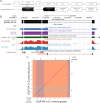This is a preprint.
Gene model for the ortholog of Glyp in Drosophila pseudoobscura
- PMID: 40777335
- PMCID: PMC12330595
- DOI: 10.1101/2025.07.18.665514
Gene model for the ortholog of Glyp in Drosophila pseudoobscura
Abstract
Gene model for the ortholog of Glycogen phosphorylase (Glyp) in the Apr. 2013 (BCM-HGSC Dpse_3.0/DpseGB3) Genome Assembly of D. pseudoobscura (GCA_000001765.2). This ortholog was characterized as part of a developing dataset to study the evolution of the Insulin/insulin-like growth factor signaling pathway (IIS) across the genus Drosophila using the Genomics Education Partnership gene annotation protocol for Course-based Undergraduate Research Experiences.
Figures

References
-
- Buzzati-Traverso AA, Scossiroli RE. 1955. The obscura group of the genus Drosophila. Adv Genet. 7:47–92. - PubMed
-
- Eanes WF, Merritt TJS, Flowers JM, Kumagai S, Sezgin E, Zhu C-T. 2006. Flux control and excess capacity in the enzymes of glycolysis and their relationship to flight metabolism in Drosophila melanogaster. Proc. Natl. Acad. Sci. U.S.A. 103:19413–19418. DOI: 10.1073/pnas.0607095104. - DOI - PMC - PubMed
Publication types
Grants and funding
LinkOut - more resources
Full Text Sources
Research Materials
Miscellaneous
